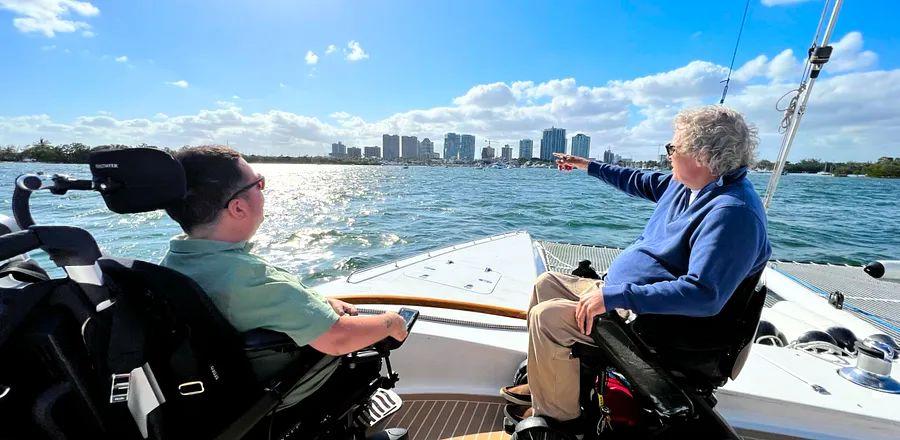Is Florida Ready to Lead in Accessible Travel?

This interview is part of the “Voices from the South” series, showcasing influential figures in the region.
As a child, Cory Lee found vacationing in Florida challenging. He recalls trips to the beach where ramps were nonexistent, motorized wheelchairs were rare, and accessibility was barely considered. Simple moments, like watching the waves crash, became daunting for his single mother, who often had to carry him to the shore.
In 2013, Lee launched the travel blog Curb Free With Cory Lee to advocate for accessibility in travel. Since then, he has explored nearly 40 countries across all seven continents, though he also enjoys local trips from his home in LaFayette, Georgia. Now at 32, Lee notes that traveling to Florida keeps improving.
In recent years, Florida has made substantial investments in accessibility, launching the 2021 campaign “Limitless Florida,” with the goal of becoming the world’s “number one” accessible destination, alongside a comprehensive guide. Visitors can experience history tours in Braille and explore accessible state parks; travelers also have the option of taking “practice trips” through virtual tours to familiarize themselves with their environment, sorted by destination, interest, or sensory-friendly activities. Florida’s dedication to accessibility is something that Lee—diagnosed with type 2 Spinal Muscular Atrophy at age two—greatly values.
Recently, Lee and I discussed what keeps drawing him back to Florida—and how the state is excelling in accessible tourism.
I’d love to hear your thoughts on traveling around Florida. What actions has the state taken to enhance accessibility?
I visit Florida at least three times a year. Over the last five years, the state has significantly ramped up its accessibility initiatives. The Florida tourism website features an impressive accessibility section with videos that highlight accessibility options across various destinations.
There’s a wealth of information available. Unlike many tourism websites—especially in the U.S.—finding accessible travel details can be challenging, but Florida simplifies the process. That’s why I keep returning, as they have genuinely increased their efforts. In my experience across Florida, I've noticed greater emphasis on making attractions and beaches more accessible. I’ve explored nearly every major city in Florida, and it just keeps improving, providing endless reasons to return.

Courtesy of Cory Lee
What are your favorite spots to explore?
If I had to choose, I would say Panama City Beach in the Florida panhandle. I absolutely love it; I’ve been going there nearly every year since I was about four, so it’s been a part of my life for a long time.
In recent years, accessibility efforts have really improved. At St. Andrews State Park and Panama City Beach, they now offer complimentary beach wheelchairs on a first-come, first-served basis, along with beach access maps. This allows me to use my powered wheelchair and roll onto the beach via a mat. There are also fantastic local companies that provide powered beach wheelchairs.
Beyond the beaches, I enjoy the history in St. Augustine, where Castillo de San Marcos is mostly accessible. I love exploring Tampa—ZooTampa is a great attraction and one of the most accessible zoos in the country—and visiting museums. The Ringling in Sarasota is among my top picks.
As a big Disney enthusiast, what do you find so special about the parks?
I believe Disney World is the best theme park for wheelchair users. Universal Studios and SeaWorld lack accessible rides, so I tend to steer clear of those. However, Disney World, especially Magic Kingdom—every Disney park has rides where I can remain in my wheelchair and still enjoy myself.

Courtesy of Cory Lee
Magic Kingdom is likely the most accessible park, offering more wheelchair-friendly rides than any other, but the other three Disney parks are also fantastic, allowing for a full day of enjoyment at the theme parks.
What does it mean to you as a wheelchair user to see Florida making strides for all types of travelers?
It’s completely transformed the experience for wheelchair users, especially at the beach. Having beach access mats is invaluable—not only for me but also for families with strollers or anyone carrying coolers, allowing them to easily navigate onto the sand instead of struggling through it.
Accessibility benefits everyone, not just those in wheelchairs. It's crucial to recognize that improving accessibility doesn't hinder anyone else. Enhancing access truly helps the entire community in the long run.
What does your ideal weekend in Florida look like?
I’d likely kick things off with a trip to the beach. It may be a bit cliché for Florida, but I would definitely spend most of Friday soaking up the sun, followed by a nice seafood dinner that evening at an accessible restaurant like Caretta on the Gulf or Bob Heilman’s Beachcomber in Clearwater.
There are so many fantastic choices; that's why I keep returning—I'm hooked on that area. On Saturday, I’d likely begin my day at the beach in the cooler morning hours, then in the afternoon, I’d check out an indoor attraction like the amazing Clearwater Marine Aquarium. In the evening, I’d indulge in some delicious seafood, and on Sunday, I’d either squeeze in one last beach visit or participate in an adaptive sport, such as sailing or boating with Shake-A-Leg in Miami.
This interview has been edited and condensed for clarity.

1

2

3

4

5
Evaluation :
5/5